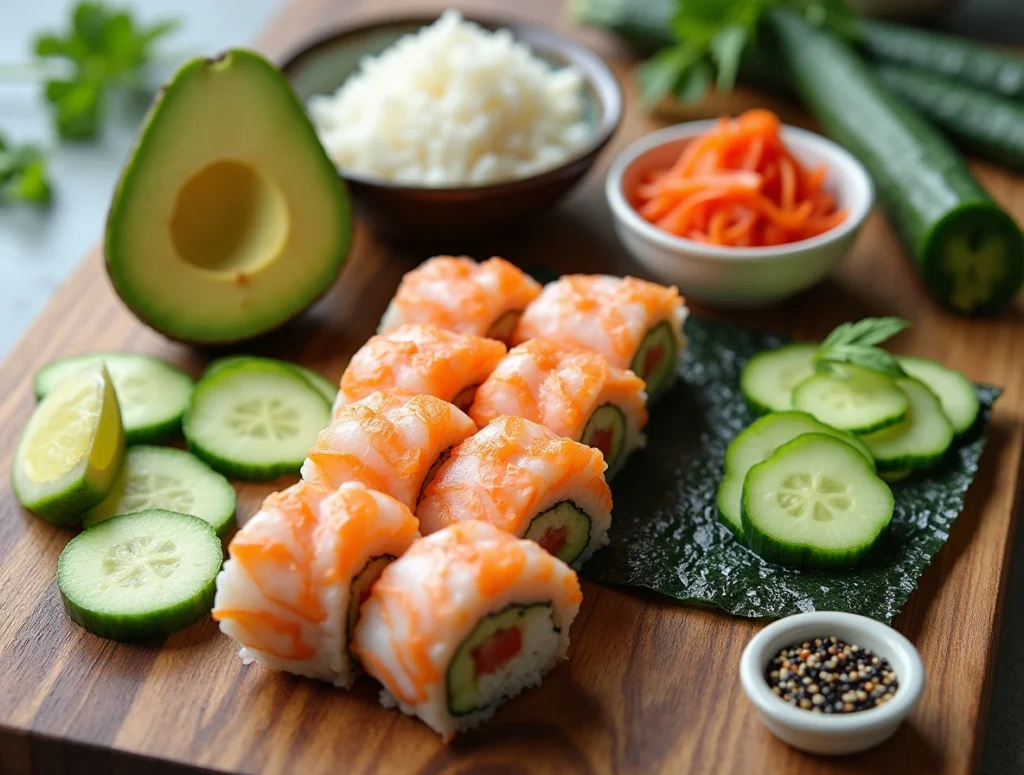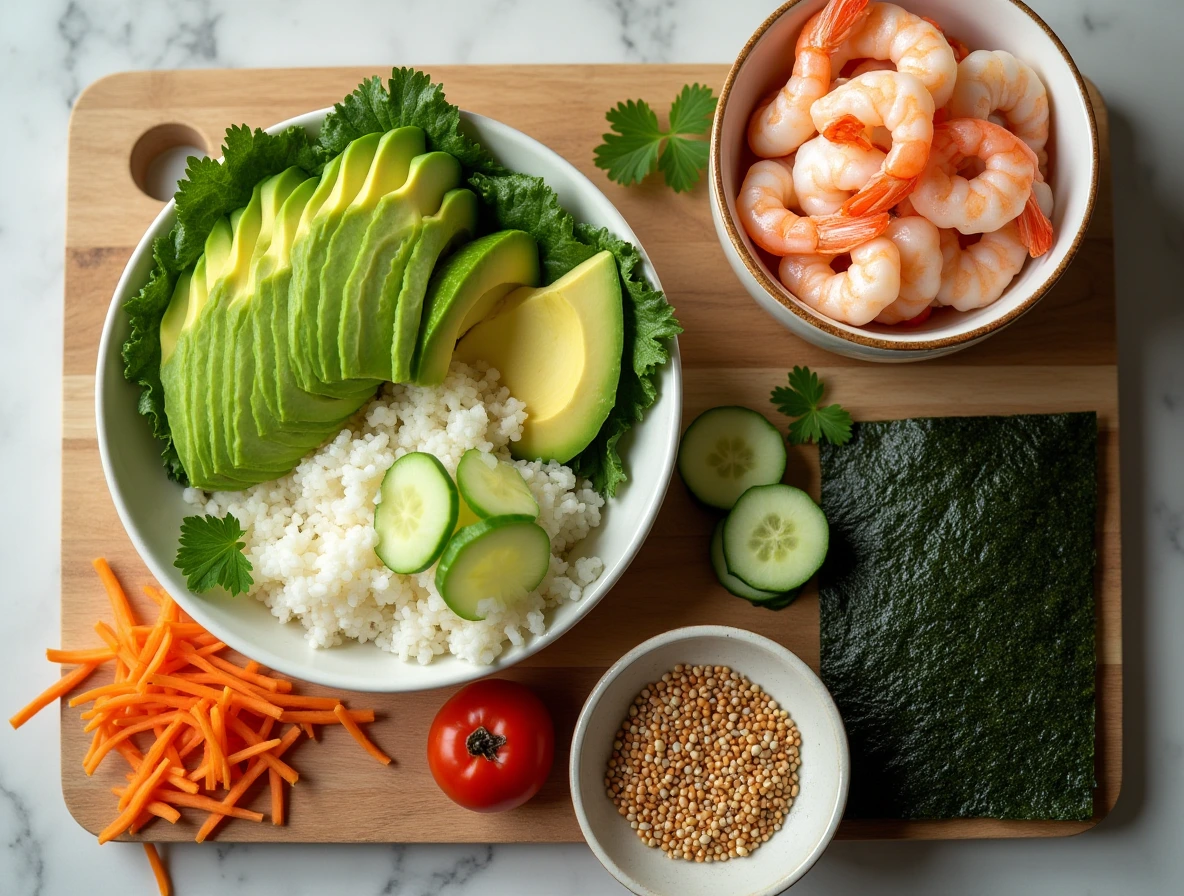If you’re craving a fresh, flavorful sushi roll that’s both beginner-friendly and packed with vibrant texture, the Boston Roll might just become your new favorite. This American-style sushi roll is a delicious twist on traditional Japanese sushi, featuring poached shrimp, creamy avocado, crunchy cucumber, and seasoned sushi rice, all wrapped in a sheet of nori (seaweed). Often garnished with spicy mayo or a sprinkle of masago (fish roe), the Boston Roll is known for its simple yet satisfying combination of ingredients.

Whether you’re a sushi enthusiast or trying your hand at homemade rolls for the first time, this guide will walk you through every step—from understanding the ingredients to mastering the art of rolling.
What Is a Boston Roll?
The Boston Roll is a maki-style sushi roll, meaning it’s rolled with the seaweed on the outside and filled with ingredients in the center. What makes it stand out is the use of cooked shrimp instead of raw fish, making it an excellent choice for those new to sushi or those who prefer not to eat raw seafood.
It’s often confused with the California Roll, but here’s how it differs:
- Boston Roll uses poached or boiled shrimp.
- California Roll uses imitation crab (surimi).
- Both include avocado and cucumber.
- The Boston Roll may be topped with spicy mayo or masago for color and flavor.
✅ Learn more about the history and regional popularity of this roll in our full article: What Is a Boston Roll?
Essential Boston Roll Ingredients
Here are the must-have ingredients to make Boston Rolls at home:
Core Ingredients
- Sushi rice – 2 cups cooked, seasoned with rice vinegar, sugar, and salt. 📖 Need help perfecting your rice? Check out this guide on How to Make Sushi Rice
- Nori (seaweed sheets) – 4 full-size sheets.
- Poached shrimp – 12 medium shrimp, peeled, deveined, sliced in half.
- Avocado – 1 ripe, thinly sliced.
- Cucumber – 1 small, cut into matchsticks.
Optional Toppings & Garnishes
- Masago (capelin roe) – for color and salty crunch. 🧐 Curious what masago is? Here’s a great comparison: Masago vs. Tobiko – MasterClass
- Spicy mayo – mix of mayo and sriracha.
- Sesame seeds – toasted, for nutty flavor.
- Eel sauce (unagi sauce) – optional drizzle for sweetness.
Ingredient Substitutions (Optional)
Want to mix things up? Try these easy swaps:
- Shrimp → imitation crab, tofu, or cooked lobster.
- Masago → tobiko or omit entirely.
- Spicy mayo → plain mayo, sriracha, or wasabi mayo.
How to Prepare the Ingredients
- Poach the Shrimp
Bring salted water to a gentle boil.
Add a squeeze of lemon juice.
Poach shrimp for 2–3 minutes until pink and opaque.
Cool in ice water, then slice in half lengthwise. - Make Perfect Sushi Rice
Rinse 1.5 cups of sushi rice under cold water until clear.
Cook using a rice cooker or pot.
Season warm rice with a mix of: ¼ cup rice vinegar
2 tbsp sugar
1 tsp salt
Fold gently and let cool to room temp. - Prepare Avocado & Cucumber
Slice avocado just before use to avoid browning.
Cut cucumber into thin matchsticks for a refreshing crunch.
How to Roll a Boston Roll (Step-by-Step)
Tools You’ll Need
- Bamboo sushi mat
- Sharp knife
- Plastic wrap
- Small bowl of water (to wet hands and knife)
Rolling Instructions
- Place plastic wrap on your bamboo mat.
- Lay a sheet of nori (shiny side down) on the mat.
- Wet your hands and spread ½ cup sushi rice evenly on the nori, leaving a ½-inch gap at the top.
- Line up your fillings: shrimp, avocado, and cucumber.
- Roll the sushi tightly from the bottom using the mat to guide you.
- Seal the edge with a bit of water.
- Slice into 6–8 pieces with a wet, sharp knife.
🎥 New to sushi rolling? This visual Sushi Rolling Guide is incredibly helpful.
🍣 You can also read a more in-depth how-to on Boston Roll Sushi from Quickly Taste.
Optional Toppings and Presentation Tips
Want to impress your guests or elevate your sushi night? Try these garnishing ideas:
- Sprinkle masago on top of each roll slice.
- Drizzle spicy mayo or eel sauce for extra flavor.
- Dust with toasted sesame seeds.
- Serve with pickled ginger, wasabi, and soy sauce on the side.
Presentation Tip: Arrange slices in a fan shape or circle on a white plate for restaurant-style plating.
🍱 Looking to try something with a twist? Check out the Philly Boston Roll variation for fusion inspiration.
Frequently Asked Questions
The Boston Roll contains poached shrimp, avocado, cucumber, sushi rice, and nori. It may also be topped with masago and spicy mayo depending on preference.
Traditionally, no. A standard Boston Roll does not include cream cheese. However, some American-style sushi restaurants may include cream cheese as a variation.
The orange topping is usually masago, which is a type of small fish roe (eggs from capelin fish). It adds both a pop of color and a slightly salty crunch.
The Boston Roll uses poached shrimp, avocado, and cucumber. The New York Roll, on the other hand, often features smoked salmon and apple, giving it a sweeter and smokier flavor profile. The ingredients and taste experience are distinctly different.
Conclusion
The Boston Roll is a flavorful, easy-to-make, and versatile sushi roll perfect for beginners and seasoned home chefs alike. With its use of cooked shrimp and classic sushi ingredients, it delivers freshness, texture, and satisfaction in every bite—without needing raw fish. Whether you’re making sushi for yourself or for guests, this roll is sure to impress. Plus, with a few toppings and plating tricks, it can look just as beautiful as it tastes.
So now that you know exactly what goes into a Boston Roll—and how easy it is to prepare—why not give it a try in your own kitchen? It’s a great way to bring restaurant-quality sushi into your home without the stress.

Boston Roll Sushi
Equipment
- Bamboo sushi mat
- Plastic wrap
- Sharp knife
- Small bowl of water
Ingredients
Core Ingredients
- 2 cups cooked sushi rice seasoned with vinegar, sugar, and salt
- 4 nori sheets full size
- 12 medium poached shrimp peeled and sliced lengthwise
- 1 ripe avocado thinly sliced
- 1 small cucumber cut into matchsticks
Optional Garnishes
- masago fish roe
- spicy mayo mayo mixed with sriracha
- toasted sesame seeds
Instructions
- Lay plastic wrap on bamboo mat. Place nori (shiny side down) on the wrap.
- Spread ½ cup sushi rice evenly on nori, leaving ½-inch border at the top.
- Arrange poached shrimp, avocado, and cucumber in a line across the center.
- Roll tightly from the bottom using the mat. Seal the edge with a little water.
- Slice roll into 6–8 pieces with a sharp, wet knife.
- Top with masago, spicy mayo, and sesame seeds if desired. Serve with soy sauce, pickled ginger, and wasabi.
